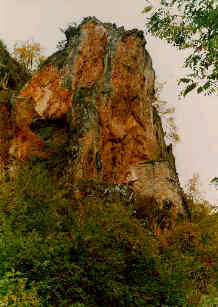
 |
The cave church of St. Athanasija (Athanasius) in Kalishta |
This cave church is about 500 meter south from the monastery in Kališta, in a rock above the Lake, with an entrance from the southern side. It can be approached via stone stairs, built recently. In the interior, the greatest ensemble of medieval paintings in the Struga region is preserved. Although no written sources are preserved, and the inscription from the outer side, from above the entrance is destroyed, the stylistic properties of these frescoes unequivocally indicate that they were painted in 1360-s. (14th century). The selection of the compositions and the saints in the interior of the church, within a relatively small space, has been made with great knowledge and moderation, and suggests that it is a painting decoration of a well educated painter (zograph).

The major part of the fresco-painting was to a great extent retouched in the 19th century. During the conservation in 1964, conserved were the original frescoes, the retouch from the 19th century was removed, except from these places where the original one was destroyed. In the upper zone, scenes from the Great Feasts are painted: Nativity of Christ, Sretenieto, Crucifixion, The Holy Women at the Sepulcher, Annunciation and the composition Deisis - where the Holy Mother of God and St. John the Baptist are bowing to Christ for salvation of sinful souls.
 Sretenie Hristovo, a fresco from the church, 14th century. |
 The crucifixion of Christ, another fresco from the church. |
From the images of saints we will mention: St. Clement of Ohrid, St. Nicholas the Miracle Worker and the busts of the martyr - saints: St. Petka, St. Marina, St. Nedela and St. Barbara - painted in rectangular frames on the south wall, imitating icons. This type of depictions originates from the 11th century, from the cathedral church St. Sofia in Ohrid.

The specificity of the frescoes in this cave church can be seen in the eclectic treatment of the contemporary; namely the dull academic Paleolog classicism that dominates in a large number of monuments from the second half of the 14th century was abandoned. Painted with one stroke, with firm forms, but with free draperies and with a feeling for contrasts of the dark and the light through the color relations, the images from this cave church are very closely related to some frescoes in the monastery church Holy Mother of God Zaum - Ohrid from 1361. Part of the artwork was painted in 19th century as well.
The church is dedicated to the archbishop of Alexandria, who lived in the 4th century, and is celebrated on the January 31 old style.